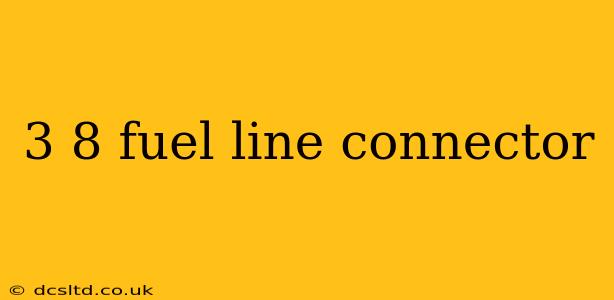Finding the right 3/8 fuel line connector is crucial for maintaining the integrity and safety of your fuel system. Whether you're working on a car, truck, boat, or other fuel-powered equipment, a reliable connection is paramount. This guide will delve into the various types of 3/8 fuel line connectors, their applications, and factors to consider when choosing the right one for your needs.
What are the Different Types of 3/8 Fuel Line Connectors?
Several types of 3/8 fuel line connectors exist, each designed for specific applications and fuel types. Understanding the differences is key to selecting the appropriate connector for your project.
-
Push-to-Connect Fittings: These are popular for their ease of use and quick installation. They typically feature a barb that grips the fuel line, creating a secure seal when pushed into place. However, they are generally suitable for lower-pressure applications.
-
Clamp-Style Connectors: Offering a more robust and secure connection, clamp-style connectors use a hose clamp to secure the fuel line to the fitting. These are ideal for higher-pressure applications and are often preferred for critical fuel lines.
-
Flare Fittings: These connectors require a flared end on the fuel line, creating a stronger seal than push-to-connect fittings. Flare fittings are often used in high-pressure systems and provide excellent leak resistance.
-
Quick-Disconnect Fittings: These connectors allow for easy and quick disconnection of the fuel line, making them ideal for situations where frequent connection and disconnection are necessary. They are often found in applications where fuel lines need to be easily removed for maintenance or service.
-
Threaded Connectors: These connectors rely on threads to create a secure and leak-proof seal. They are typically used in higher-pressure applications and offer excellent durability.
What Material are 3/8 Fuel Line Connectors Made Of?
The material of your 3/8 fuel line connector is crucial for its compatibility with different fuels and for ensuring its longevity. Common materials include:
-
Steel: A durable and reliable option, especially for higher-pressure applications. Steel connectors are often zinc-plated or coated to resist corrosion.
-
Brass: Known for its corrosion resistance and durability, brass is a suitable choice for many fuel line applications.
-
Aluminum: A lightweight and corrosion-resistant option, aluminum connectors are often used in applications where weight is a factor.
-
Plastic/Nylon: While generally suitable for lower-pressure applications, plastic connectors offer a cost-effective solution for many fuel systems. However, always verify their compatibility with your specific fuel type.
How Do I Choose the Right 3/8 Fuel Line Connector?
Selecting the correct 3/8 fuel line connector involves considering several factors:
-
Fuel Type: Different fuels have varying chemical properties. Ensure the connector is compatible with the specific fuel you'll be using.
-
Pressure Rating: The connector's pressure rating must be higher than the maximum pressure in your fuel system to prevent leaks and ensure safety.
-
Hose Size: Confirm that the connector's inner diameter matches the outer diameter of your fuel line.
-
Application: The type of connector needed will depend on the application. High-pressure systems may require flare or clamp-style connectors, while lower-pressure systems might be suitable for push-to-connect fittings.
What are the potential problems with a faulty 3/8 fuel line connector?
A faulty 3/8 fuel line connector can lead to several serious problems:
-
Fuel Leaks: The most immediate and dangerous consequence is a fuel leak, which can result in fire hazards.
-
Reduced Fuel Efficiency: Leaks can cause a loss of fuel pressure, leading to reduced engine performance and decreased fuel economy.
-
Engine Damage: A lack of consistent fuel supply can damage the engine due to fuel starvation.
-
Environmental Concerns: Fuel spills can pollute the environment and pose a significant risk to the surrounding area.
How do I install a 3/8 fuel line connector?
The installation process varies slightly depending on the type of connector. Always refer to the manufacturer's instructions for specific installation details. Generally, it involves:
-
Preparing the Fuel Line: Cut the fuel line to the correct length and ensure the end is clean and free from debris.
-
Attaching the Connector: Depending on the type of connector, this might involve pushing the line into a barb, clamping it in place, or using threading mechanisms.
-
Securing the Connection: Ensure the connection is tight and secure to prevent leaks.
-
Testing: After installation, carefully inspect the connection for leaks and test the fuel system to ensure proper functionality.
Remember, working with fuel systems requires caution. If you're not comfortable with the process, it's always best to consult a professional mechanic. A properly installed 3/8 fuel line connector is vital for a safe and efficient fuel system.
